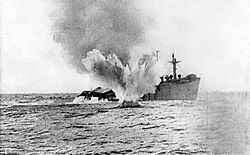Battle of the Atlantic
The Battle of the Atlantic was the longest continuous military campaign in World War II to defeat the Germans in 1945. The British Royal Navy repeated the blockade of Germany of World War II, and Germany repeated its attempt to blockade Britain by using U-boats. The German Navy also tried to use surface warships in the Atlantic Ocean, but lost them in various battles.
Notes and References
Battle Of The Atlantic Media
German submarine pens in Lorient, Brittany
Grand Admiral Erich Raeder with Otto Kretschmer (left), August 1940
The battlecruiser HMS Hood (in the distance) steaming into battle minutes before being sunk by the German battleship Bismarck on 24 May 1941
A SB2U Vindicator scout bomber from USS Ranger flies anti-submarine patrol over Convoy WS-12, en route to Cape Town, 27 November 1941. The convoy was one of many escorted by the US Navy on "Neutrality Patrol", before the US officially entered the war.
The distinctive HF/DF "birdcage" aerial can be seen at the masthead of HMS Kite








